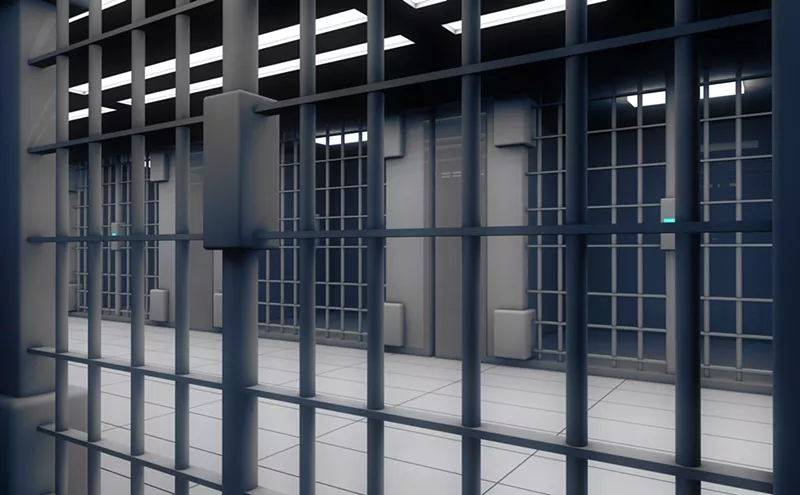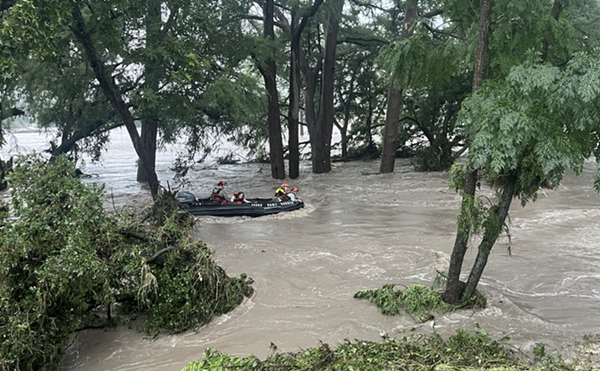For a long time, a central part of Dallas' self-concept was the idea that this city had no natural features. At all.
The idea was always dead wrong.
In fact, because large tracts of land had been neglected and ignored by developers from the city's earliest days, Dallas always had more truly untouched or lightly touched terrain than many American cities, maybe even most of them. The thing protecting that terrain from touch was always the powerful conviction that it did not exist — a strange notion that just would not die.
Historian Harvey J. Graff opens his 2008 book The Dallas Myth with a dissection of the city's stubbornly persistent "no reason to exist" creation myth. If you haven't heard it, it was the story that because there was no seaport here — no trail, no mountain peak or pass to explain why people built a city in the first place — Dallas was entirely the creation of the human mind and will. And that was supposed to be a good thing.
Robert Lee Thornton, mayor of Dallas in the 1950s, called the city "truly a man-made and woman-made city," with no ties to or origin in the natural world or, for that matter, history. Thornton said the people of Dallas knew all along they could find plenty of history in books and museums if they had time to kill. "What they wanted was progress," he said.
The late A.C Greene, a journalist and novelist, shot down all of that "no reason to exist," laying out all of the crucial natural factors that caused people to settle here and build a city, from ancient Indian trading trails to the Trinity River. But that didn't stop people from saying it. Dallas, it seemed, loved the idea that it was a glittering, glamorous, cryogenically air-conditioned space station whirling through a blazing void infested by ticks, chiggers, snakes and double-wide salesmen. If we could be here and still have really good bars and restaurants, we could do it on the moon.
The others? They could keep their mountains, their beaches, their ruins and their relics. We had our man-made shell to keep us cool.
But that era is over. Without fanfare or formal declaration, this region has turned away from the city's long love affair with artificiality and is now engaged in a vast exploration of our natural setting. Quietly and incrementally, the region has developed what is becoming a wealth of trails and parks designed around nature and the outdoors.
The suburbs, especially those north of the city, have led the way, with vast public investment in assets like the Campion Trails network along the Elm Fork of the Trinity River. Dallas is catching up. Two city council members, Angela Hunt and Scott Griggs, recently announced that they would using discretionary funds to create a paved bike path along the Trinity from upstream of downtown to the opening of the Great Trinity Forest downriver from the city center. And out ahead of this formal municipal activity, a hearty band of urban bushwhackers have been exploring the city's thousands of acres of lost and forgotten land. Their particular form of bushwhacking involves deliberately steering away from formal public parks — the places where everybody else goes — in search of the natural discoveries no one even knows are out there to be found.
Some of it is rough going — places where no one should wander alone or unawares. In some, you could get lost or injure yourself in wild and unforgiving terrain. In others you might stumble into criminal activity — never a welcome encounter on a Sunday-morning hike.
But the places the bushwhackers have uncovered in our urban midst also include some jewels, havens of true wonder, far wilder and closer to nature than anything a parks department could take responsibility for. The bushwhackers include people like Randy Johnson, who was up until recently director of horticulture at The Dallas Discovery Gardens in Fair Park; Charles Allen, the Trinity River Expeditions canoe outfitter; Master Naturalist Jim Flood; and archaeologist Tim Dalby. They all helped identify some whackable bush for this article.
In an urban environment, the work of finding these places sometimes must be followed by the even harder work of excavating them from decades of neglect. That labor often falls to corporate volunteers, like the employees of REI who helped create the treasure listed here as "Dimension Tract." Nonprofit foundations like Groundwork Dallas have accomplished similarly Herculean tasks: Groundwork director Peter Payton led armies of volunteers into the Tune Avenue site over a period of years to haul out vast mountains of dumped tires and appliances. Tune Avenue still isn't a good idea for Cub Scouts — too much danger of running into a marijuana farm — but it's a place where the bravest bushwhackers now can see deer, bobcat, coyote and mink flying through a forest that is rapidly reclaiming abandoned urban streets.
Randy Johnson talks about urban bushwhacking as an experience more exciting than what he could find in even a national park. For him, this is real exploring, like what the first French fur traders did in Canada. It's all about finding places nobody knows about.
"You have to ask yourself why you actually go out into the wilderness or into nature," he says. "What is it you are trying to get there?
"If you want a very kind of clinical experience, yeah, just go to your everyday average state or national park. But I'm telling you, you're going to get more of a wilderness experience doing what I do than if you go to a lot of places like Yosemite.
"The main thing is that nobody even knows all the potential that's around in the city, because we don't think it's out there. Along with the Styrofoam and the Dixie cups and everything else, you're going to be just amazed."
The locales described here are only a sampling of what's out there. We've also included a list of valuable websites where you'll find descriptions and directions to far more places, some of which may be closer to your own interests.
The words of caution here are serious. Some of these places are safe, in terms of the other people you might encounter. Others, not so much. We have assigned a very informal subjective weighted score to these sites, calculated as follows: points from zero to 10 for "civilized," meaning the presence of bathrooms and possible police patrols, plus points for "wild," meaning an opportunity to see plants, animals and scenery in a wild state. Points are subtracted for "skeezy," meaning the likelihood of wandering upon a drug deal or something similarly not to be wished for.
All of the sites include GPS coordinates. Even if you don't have GPS, you can type the coordinates into the "find" field in Google Maps and get a precise map or driving directions (web editor's note: we've hyperlinked them for you below). We also include our own driving directions, because sometimes Google's directions don't exactly match what you'll see out the windshield or beyond your handlebars.
Ultimately, this isn't just about parks and trails. It's a movement toward the rediscovery of nature in our urban midst, and it's redefining this city and our life in it. It's a reconnection with history. It's certainly not an abandonment or negation of Mayor Thornton's beloved progress. But it may have a lot to do with a desire to make something better of the present, since that's where we happen to live.

(all photos by Jay Barker)
Family-Friendly
River Legacy Park: The White Rock Of the Mid-Cities
Score: 12 (Civilized 10, Wild 2, Skeezy 0)
No lake here, but the park is nestled in a bend of the West Fork of the Trinity, and it sure looks like White Rock on a weekend, with bikers, hikers and picnickers galore. Paved bike trails, dirt nature trails, picnic space, portable toilets.
Coordinates: N32 46.966 W97 07.004 . Take Interstate 30 west from downtown 18 miles, Take Exit 27 toward Cooper Steet, turn right (north), go 1.6 miles, turn left on NW Green Oaks Boulevard. Entrance is 0.1 mile on your right at Rose Brown May Parkway.
Family-Friendly

Mountain Creek Preserve: Lost Paradise
Score: 15 (Civilized 8, Wild 7, Skeezy 0)
Dog frisbee and moderate bushwhacking. Large mowed fields, dirt and paved trails along the West Fork of the Trinity River.
Coordinates: N32 47.174 W96 56.040 . Take I-30 west from downtown Dallas approximately eight miles to MacArthur Boulevard. Take Mac-Arthur Boulevard north half mile, turn right (east) on Hunter Ferrell Road back toward downtown, go 1.5 miles to the intersection with South Nursery Road. Preserve will be at that corner. For trails, go to the far back parking and cross the bridge. You can walk for miles here and connect to other parks in the Irving Campion Trails system.
Dimension Tract: The Chapel
Score: 9 (Civilized 2, Wild 7, Skeezy 0)
A short, broad trail beneath a Gothic arch of branches, with contemplative benches and steps down to the Elm Fork of the Trinity River. Not a lot of space to explore, but a wonderfully surprising haven of nature surrounded by huge warehouses and quasi-industrial blah. If you ever wanted to see what it all must have looked like in the way-back back-before, come here. You will also find a mowed field right at the parking lot, a favorite with dog frisbeers (and the guys throwing the frisbees).
Coordinates: N32 56.907, W96 56.236. Take I-35E north toward Denton about 14 miles from downtown, get off at Exit 443B toward Belt Line Road, go left (west) 1.5 miles (under President George Bush Turnpike). Turn left on Westward Drive into a bunch of industrial buildings, go about 300 feet to Elm Park Drive, turn right to the dead-end. Trail head is marked.
A Little More Out There

Quanah Parker Park: Ghost of the Comanche
Score: 17 (Civilized 9, Wild 8, Skeezy 0)
Named for the last great Comanche war chief, this park is connected by improved trails to a series of parks on the Southern Campion Trails system. But it's also a good example of an even wilder experience you can find if you're willing to risk drowning or getting bitten by a poisonous snake. If that's your idea of a good time, bushwhack your way off the formal trails and find game tracks and other small trails along the banks of the Trinity River.
Coordinates: N32 46.226 W97 14.571. Take I-30 west from downtown 25 miles past Loop 820. Get off at Exit 18 for Bridge Street, make a sharp right onto Bridge, doubling back east about 0.6 mile on the north side of I-30. Turn north (left) on Woodhaven, go 0.7 mile. Woodhaven dead-ends into the entrance to the park, just across Randol Mill Road.
Definitely Out There

Joppa Preserve: The Serengeti
Score: 10 (Civilized 4, Wild 10, Skeezy 4)
Named for one of the state's longest enduring Freedman's Towns (pronounced "Joppy" by the old guard), Joppa Preserve offers miles and miles of paved walking and bike trail looping around small lakes and ponds. During migratory season, it's crazy with birds, like a scene from Wild Planet. If you're on a bike, your biggest hazard may be people stopping to take pictures. Off the paved trails, Joppa Preserve is wild — an entryway into the Great Trinity Forest and who knows what.
Coordinates: N32 42.375 W96 44.275. Take I-45 for 5.6 miles south from downtown to the Loop 12/Ledbetter/Great Trinity Forest Boulevard exit. Go left (east) on Great Trinity Forest about 0.9 mile. You will see signs on the right-hand service drive saying "Dead End" and "No Outlet." That's your welcome. Turn onto the service road. You have to keep going on the service road past where you think you can go. You will see a neat new parking lot on your right with a trail entrance. You can also park just ahead under the bridge at the Loop 12 Boat Ramp.
Definitely Out There
California Crossing Bike Trail: Whack a Mole, and Guess Who's the Mole
Score: 8 (Civilized 4, Wild 7, Skeezy 3)
Trail around old gravel borrow pits, now wild ponds and lakes, on nice trails improved and used by bikers. Walk against traffic, listen hard around blind corners, don't even think about it on a Saturday. Otherwise, these are very nice trails not terribly far from downtown.
Coordinates: N32 51.995 W96 55.367. Take U.S. Highway 114 John Carpenter Freeway toward the airport about 10 miles from downtown, exit at Riverside Drive, turn right, go 0.8 mile to California Crossing Road, turn right again. Two tenths of a mile ahead, California Crossing Park will be on your left. But don't stop there. Go another 300 feet and turn into a parking lot on your right with a big pond on your left.
Trinity River Greenbelt: Deep City Wilderness
Score: 7 (Civilized 0, Wild 10, Skeezy 3)
This area is almost invisible from a fast-moving car on the surrounding highways, and the highways will disappear and go silent the moment you enter this forgotten forest in the heart of the city. Motorized vehicles are illegal. It takes some walking and maybe a little getting lost to find this place.
Coordinates: N32 50.465 W96 52.224. Take I-35E north from downtown to Regal Row, exit right a short hop to Harry Hines Boulevard, turn left, go 0.4 mile. Entrance to Greenbelt is on your left. Just beyond it on the right is Strokers Motorcycles.
You are looking for a dirt parking lot with a sign that says "Reserved Area, NO Unauthorized Entry." That's where you'll enter. Go left of the metal fenced area onto a dirt track. Ahead will be a locked gate. Park there.
You need to walk around the gate (it's city land, open to walkers), go up and over the levee, then north along I-35E to a bridge that will allow you to cross under. Right there you are at the entrance to a vast system of informal trails along the Trinity River.
Gateway Trail: Dallas' Alps
Score: 9 (Civilized 5, Wild 10, Skeezy 6)
Gateway Trail is a loose nomenclature for a series of trails up, down and along the southern White Rock Escarpment in southeast Dallas. You can find yourself on steep inclines and steep descents, wrapped in trees and birdsong, in deep-woods ravines where you could imagine you're hiking somewhere outside of Santa Fe.
Much of this area has never been developed. It's not unusual to find Indian artifacts and wild orchids out here, not to mention plentiful wildlife.
The skeezy score is awarded here because you can also happen upon groups of young dope smokers and occasionally even more sketchy characters, especially where the trails are still close to nearby neighborhoods.
This is a vast area. If you ever do manage to get beyond the DART tracks, you can get seriously lost out there. You can also see some very serious nature, from gators to bobcat.
Baseball diamond entrance. Coordinates: N32 45.434 W96 42.219. Take I-30 east to Jim Miller Road, go south two and half miles; 800 feet beyond Scyene Road look for the Gateway Park baseball diamond and parking on your right. To the right of the diamond, look for a green electrical box on the ground, about three feet high, with wooden bollards just to the right of it. That's the trail entrance.
Gateway Renda Street entrance. Coordinates: N32 45.674 W96 42.270. Take Scyene west from Jim Miller 0.2 mile, turn left or south on Renda Street. Go 0.1 mile to where the street ends at Lacywood Lane. There is a locked and closed parking lot on your right. You will have to park on the shoulder of Renda or Lacywood.
Out beyond the parking lot is a trailhead sign. This trail will take you down to the bottoms, but eventually you will be walled off by a fenced DART right-of-way. If you walk northwest along the tracks you will come to a weird intersection to nowhere, where you can cross. Beyond this point, you are in the really big land, the area where you can get lost. Tell us if you find Big Foot.
Gateway golf course entrance. Coordinates: N32 45.434 W96 42.350. It's on down Jim Miller from the ball diamond less than 0.1 mile on your left. Go into the entrance to Grover Keeton Golf Course. Go the rear parking lot right (north) of the clubhouse. You will see a weathered trail sign on the edge of the lot that says "Gateway Trail." It's an easier way in than the others.
No, Look, This is SERIOUSLY Out There

Tune Avenue: Nature Post-Apocalypto
Score: 1 (Civilized 0, Wild 10, Skeezy 9)
This place used to be way worse. Groundwork Dallas, a nonprofit, came out here with armies of volunteers and, we hope, gallons of bug repellent, and pulled out vast mountains of tires and other junk dumped in the woods over a half century. Barely visible beneath the undergrowth now are the bleached bones of streets and foundations where a neighborhood was erased decades ago to solve flooding problems.
What you see now is nature coming back with a fury to reclaim the land. It's a window on a process that's the opposite of what most of us have observed all our lives. We've seen cities and suburbs sprawling across the land and erasing every vestige of nature. Here you can see deer, bobcat, coyotes and incredible bird life flooding back in to restore nature's hegemony, as well as wonderful plant and tree diversity and one hell of a lot of poison ivy. What you do not want to find out here — but might — is an occupied pot farm or zombies. Then you need to outrun the deer.
Coordinates: N32 44.556 W96 43.519. Take I-45 south from downtown to exit 283B onto U.S. Highway 175 east toward Kaufman. Go four miles to the 2nd Avenue/Bruton Road exit. Turn right or south halfway around the little cloverleaf, look for Tune Avenue, barely visible on your right. You will see a locked gate ahead. The strange car-wrecking people live just down the little dirt track to your left. You don't want to go down there and poke around. Do you?

Goat Island: Huck Finn's Hideout
Score: 9 (Civilized 0, Wild 9, Skeezy 0)
A sandy trail lane leads you deep into forested land along the Trinity River. If there was ever an island here, it is no more, but you can sure go deep into the woods and never guess you're 20 miles from downtown. Take water and bug repellent.
Coordinates: N32 37.965 W96 39.736. Go south on I-45 12 miles from downtown to Fulghum Road. Turn left or east on Fulghum Road and go 1.9 miles to Post Oak Road. Turn right (south) 0.3 mile on Post Oak. Post Oak jogs left or east after another 10th of a mile. At the corner where it jogs south again is the entrance to Goat Island.












